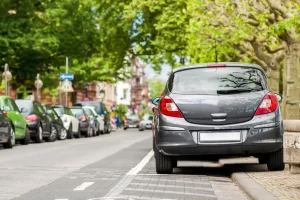How the new Volvo EX90 electric SUV adds revolution to the brand's evolution

The all-new, all-electric Volvo EX90 does not appear to be radically different from the XC90, the vehicle it will eventually replace. It has nearly the same dimensions, inside and out. It sports familiar, familial design cues, including T-shaped “Thor’s Hammer” headlights, a squared-off hood and roofline, sharply-swaged and deeply-scalloped flanks and tall taillights that fringe the hatch. Inside, three accessible rows of seats are done up in an upscale Scandinavian Modern motif, like an Arne Jacobsen furniture showroom. But if one looks closely, one begins to notice key differences.
First, there is the blunt, closed snout up front. It may be grille-less, but it’s still bedecked with Volvo’s Iron Mark. Then, dead centered above the rearview mirror, like a pair of reading glasses canted atop one’s forehead, is a protruding hump. These hint at the EX’s most comprehensive distinctions from its predecessor. The new full-size crossover is engine-less, the first Volvo to be built on an all-new battery-powered electric vehicle platform. And housed in that hump, is another first, the initial consumer vehicular integration of a functional lidar — like radar, but using light instead of sound waves — used to allow the car’s advanced driver assistance systems (ADAS) to “see” further down the road, even around bends and through some objects. Eventually, allegedly, it will also allow for “unsupervised driving” capabilities.
Both of these features are signifiers of Volvo’s latest, but ongoing, missions. The first is its commitment to a full electrification of its entire passenger car fleet, which it plans to accomplish by the end of this decade. The second is the brand’s well-known leadership in vehicular safety. Volvo claims that its new suite of sensors (16 ultra-sonic, eight cameras, five radars and the lidar) can help prevent 10% of vehicular collisions and 20% of serious injuries, part of the brand’s mission to prevent anyone from being killed or seriously injured in a Volvo. There’s even a group of sensors monitoring the driver’s wellbeing to make sure they’re not sleepy or wasted, while concurrently scanning the passenger compartment to ensure that no child or pet was left behind due to that aforementioned tired or inebriated state. If they forget, they’ll get an alert on their phone, which is also their key, and the A/C or heater will automatically turn on so the precious (yet forgotten) cargo doesn’t bake/freeze.

At launch, the EX90 will be available with all-wheel drive and up to 496 horsepower, allowing it to launch from 0-60 mph in around 4.7 seconds, comparable to the high-test version of the XC90 it replaces. The big 111 kilowatt-hour battery provides as much as 300 miles of range, and when connected to a high-speed charger — if you can find one, and it happens to work — claims to be capable of re-juicing from 10% to 80% in around 30 minutes thanks to its very quick 250-kW max DC charging rate.
Inside, the mid-century-modern vibe — clean and uncluttered, while simultaneously cushy and pampering — reflects Volvo’s continued progression upmarket, away from the Buicks and Acuras and toward Audis and Mercedeses. (As does the price tag, which is expected to approach $80,000, well-equipped.) But while the surfaces retain their familiar sheen, the materials used reflect the brand’s sustainability promises, en route to carbon neutrality in sourcing and manufacturing by 2040. These include lovely wool seats woven with polyester thread derived from old plastic, Nordico vinyl on doors and dash made from Swedish pine resin and plastic bottles, 3D-printed aluminum, and wood trim with micro-perforations that allow patterns of light to shine through at night. The overall effect inspires a sense of both soothing and delight.
A vertical, tablet-like 15-inch screen takes up much of the central dash. The cleanliness of this central space is belied by the absence of hard switches, as the touchscreen also controls functions like climate adjustment and even the opening of the glovebox, ones that might better, and more safely, be served by knobs and buttons. The ongoing trend of forcing everything into a screen seems narrow-minded. We can only hope it reverses soon.



One area where screens are smartly not present is in the rear rows. That is, unless your passengers bring their own, which they will. Volvo wisely isn’t peddling rear entertainment anymore, recognizing that everyone in the car has their own familiar device in their pocket, bag or, likelier, hand. It will sell you a mount for such a device, however, with an integrated charging port. Other such ports abound, ensuring that occupants will not have to quarrel, at least on that point, and will emerge recharged, if not physically, then at least electronically.
Bi-directional charging also allows owners to use the EX90 to power other objects, like hand tools, a blender, a toaster, etc., most of which one could store in the vehicle’s spacious front and rear cargo trunks — yes, as in there is a trunk-like compartment under the regular cargo area floor.
The XC90 has been the product that — design-, ergonomic and engineering-wise — led Volvo’s renewed vehicular charge under the deep-pocketed auspices of its latest corporate overlord, the Geely Group of China. So we expect that additional forthcoming electric vehicles from the brand, replacements for its similarly aging S60 and S90 sedans (if it bothers to replace sedans), V60 and V90 wagons (ditto), and XC60 and XC40 crossovers (ka-ching), will be built around this same scalable battery-operated architecture.
It may have been preferred for the design language to take a few more risks, abiding the handsomely angular and extruded form of the “Recharge” concept the brand unveiled in 2021. But even a casual glimpse at the brand’s design history reveals that the marque rarely thinks outside of the box in this realm. In fact, its best-known designs, the series of rectilinear models in the final decades of the 20th century, were, well, boxy. Volvo has found an expression that conveys formality, refinement and stolidity, which aligns well with its core virtues of longevity, reliability and especially vault-like security. To belabor another instance of not-so-clever wordplay, in its shift to electrification and enhanced ADAS, Volvo is playing it safe.
Related video:


